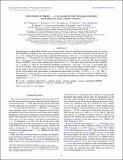DISCOVERY OF THREE z > 6.5 QUASARS IN THE VISTA KILO-DEGREE INFRARED GALAXY (VIKING) SURVEY
Author(s)
Venemans, B. P.; Findlay, J. R.; Sutherland, W. J.; De Rosa, G.; McMahon, R. G.; Kuijken, K.; Lewis, J. R.; Simcoe, Robert A.; Gonzalez-Solares, E. A.; ... Show more Show less
DownloadVenemans-2013-DISCOVERY OF THREE z.pdf (1.292Mb)
PUBLISHER_POLICY
Publisher Policy
Article is made available in accordance with the publisher's policy and may be subject to US copyright law. Please refer to the publisher's site for terms of use.
Terms of use
Metadata
Show full item recordAbstract
Studying quasars at the highest redshifts can constrain models of galaxy and black hole formation, and it also probes the intergalactic medium in the early universe. Optical surveys have to date discovered more than 60 quasars up to z [~ over _] 6.4, a limit set by the use of the z-band and CCD detectors. Only one z [> over ~] 6.4 quasar has been discovered, namely the z = 7.08 quasar ULAS J1120+0641, using near-infrared imaging. Here we report the discovery of three new z [> over ~] 6.4 quasars in 332 deg[superscript 2] of the Visible and Infrared Survey Telescope for Astronomy Kilo-degree Infrared Galaxy (VIKING) survey, thus extending the number from 1 to 4. The newly discovered quasars have redshifts of z = 6.60, 6.75, and 6.89. The absolute magnitudes are between –26.0 and –25.5, 0.6-1.1 mag fainter than ULAS J1120+0641. Near-infrared spectroscopy revealed the Mg II emission line in all three objects. The quasars are powered by black holes with masses of ~(1-2) × 10[superscript 9] M [subscript ☉]. In our probed redshift range of 6.44 < z < 7.44 we can set a lower limit on the space density of supermassive black holes of ρ(M [subscript BH] > 10[superscript 9] M [subscript ☉]) > 1.1 × 10[superscript –9] Mpc[superscript –3]. The discovery of three quasars in our survey area is consistent with the z = 6 quasar luminosity function when extrapolated to z ~ 7. We do not find evidence for a steeper decline in the space density of quasars with increasing redshift from z = 6 to z = 7.
Date issued
2013-11Department
Massachusetts Institute of Technology. Department of Physics; MIT Kavli Institute for Astrophysics and Space ResearchJournal
The Astrophysical Journal
Publisher
IOP Publishing
Citation
Venemans, B. P., J. R. Findlay, W. J. Sutherland, G. De Rosa, R. G. McMahon, R. Simcoe, E. A. Gonzalez-Solares, K. Kuijken, and J. R. Lewis. “DISCOVERY OF THREE z > 6.5 QUASARS IN THE VISTA KILO-DEGREE INFRARED GALAXY (VIKING) SURVEY.” The Astrophysical Journal 779, no. 1 (November 22, 2013): 24. © 2013 The American Astronomical Society
Version: Final published version
ISSN
0004-637X
1538-4357